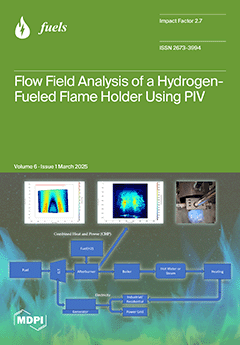The current investigation aims to offer fundamental, molecular- to microscopic-level descriptions of methane gas inside natural source clay minerals. Texas montmorillonite (STx-1), Georgia kaolinite (KGa-2), and Ca
2+-saturated Texas montmorillonite (Ca-STx-1, Ca-bentonite) were utilized as subsurface model clay minerals for elucidating nano-confinement
[...] Read more.
The current investigation aims to offer fundamental, molecular- to microscopic-level descriptions of methane gas inside natural source clay minerals. Texas montmorillonite (STx-1), Georgia kaolinite (KGa-2), and Ca
2+-saturated Texas montmorillonite (Ca-STx-1, Ca-bentonite) were utilized as subsurface model clay minerals for elucidating nano-confinement behaviors of
13C-labeled methane gas. High-pressure magic angle spinning (MAS) nuclear magnetic resonance (NMR) was used to describe the interactions between methane and the clays by varying temperature and pressure. Proton-decoupled
13C-NMR spectra were acquired at 28.2 bar at 307 K, 32.6 bar at 346 K, 56.4 bar at 307 K, 65.1 bar at 346 K, 112.7 bar at 307 K, and 130.3 bar at 346 K. In the pure state, no significant thermal effect on the behavior of methane was observed. However, there was a perceptible variation in the chemical shift position of confined methane in the mixtures with the clays up to 346 K. Conversely, the
13C-NMR chemical shift of methane altered by varying pressure in a pure state, and the mixtures with clays, attributed to the interaction of methane with the clay surfaces or the nanopore network of the clay–silica mixed phase. Pressure-induced shifts in methane peak positions were observed: 0.25 ppm (28.2–56.4 bar) and 0.47 ppm (56.4–112.3 bar) at 307 K. For methane in a montmorillonite mixture, shifts were 0.32 ppm for bulk-like methane and 0.20 ppm for confined methane under similar conditions. At 346 K, increasing pressure from 65.1 to 130.3 bar caused shifts exceeding 0.50 ppm, with bulk-like methane showing a 0.64 ppm shift and confined methane a 0.57 ppm shift. There was only one
13C-NMR methane peak in the mixture with either kaolinite (KGa-2) or Ca-bentonite with line broadening compared to that of pure methane. Still, two peaks were observed in the mixture with STx-1, explained by the imbibition and mobility of methane in the pore network.
Full article




